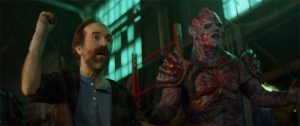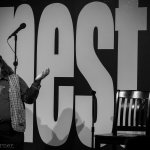Chairs at the Fringe
Chairs, an award winning play written by Sebastien Archibald, directed by Jen Quinn, and performed by Paul Naiman, Brandon Roy, and David Sklar, is an exploration of the evolution of man. This dark comedy seems to be an analogy for the industrial revolution and the system of control we have built for ourselves. It says we are slaves of the system, but our voluntary compliance is what maintains that system.
Between the strange wooden chairs, which are assembled live on stage, and the shadow puppet box that gives us a visual reference as to what the characters are seeing, the set was minimalistic and beautiful. Not only are we witness to the trees being chopped down, but we can feel time pass with the rise and fall of the sun, and the seasons changing.
The story begins with everyone on a level playing field. Three men spend their days sitting on the floor staring into the distance. One of them, sick of the mundane, searches for more. Scared of change, and believing that failure is inevitable, the pessimist resists every idea he has. Though easily swayed to one side or another, the wishy washy one often sides with the pessimist at first. The innovator becomes frustrated with their constant discouragement. He needs their help to bring his vision to life, but they are lazy, apathetic, with no ambitions. Somehow he convinces them to help him build his invention, the chair.
While up on the chair, the innovator cannot acquire food, and needs the others to serve him. Though he could not build the chair without them, nor is his new platform sustainable without the cooperation of his peers, he is the only one who reaps the rewards. He “sells” them on helping. He manipulates them into believing that the new hierarchy that has been created makes sense. He ignores their pleas to share, and they accept it. His higher status is preserved at their expense, and ironically created by their voluntary compliance. They begin to resent him, but then rationalize the benefits of the system even though they have clearly become his slaves.
Eventually they build another chair which leaves only one of them, the pessimist, to do the work of three while the other two sit on their pedestals. He becomes upset at his situation so they threaten to replace him. Realizing that there is no one to replace him with, he calls their bluff and leaves them to starve. The system of slavery would have at this point met it’s demise, but the pessimist returns when ill and they provide what he needs to keep him alive to continue his work. He fears that they have run out of food, but the chairs create a visual perception that allow them to scout for food far away. Feeling dependant on this new technology the pessimist returns to his position as a slave for the system. This is a representation of how we comply with a broken and oppressive system out of fear of the unknown, and fear of the loss of the comfort and security that the system promises.
As a reward, the two on the chairs commend the slave for his hard work and commitment. This gives him the confidence to ask for a “promotion”, as in his very own chair. They say no. There are not enough resources left to build him a chair, and if he gets on a chair there will be no one else to serve the system by doing the labour and bringing them food. He has worked everyday hoping that he was working towards his dream of having the luxuries his peers have, but finally he realizes that, in this system, it would never be possible.
Upon learning this, he tries to leave. In fear that they will lose their comfy positions and privileges, one of the men on the chairs uses a dirty tactic to keep their slave working. He gives him hope… hope that one day he can build his own chair. This shows us how the American Dream, the dream that keeps us as slaves in the system of control, is heavily dependant on the illusions that give us hope that we can one day, if we work long and hard enough, have our very own piece of the pie. In reality it is mathematically unlikely, and those in control change the rules so often to benefit their monopoly that the banks get bailed out with the working class’s tax money just in time to evict hard working citizens into a reality of homelessness.
This story shows us that without those who strive for more, and inspire others to join them, as in leaders, we would never achieve “progress” and develop technology. However, what is the cost of this “progress”? Is the narcissism and greed a consequence of the journey to achievement. Maybe one grows resentful of those who scoffed at their dreams and discouraged them. Maybe we allow ourselves to be led in the wrong direction. Maybe this is all just a part of human evolution and now is the part of the story where we wake up to the truth, accept our responsibility, and make an effort to face our fear of change and the unknown to create a society that fulfils all of our needs, and sets us free.
What do you think? Leave your comments below.














